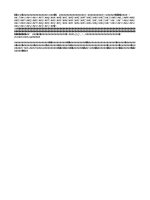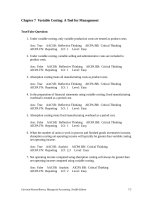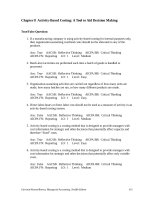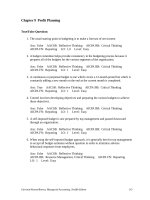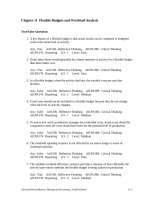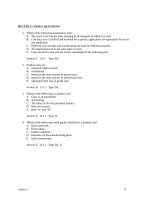Test bank managerial accounting 15e ch1
Bạn đang xem bản rút gọn của tài liệu. Xem và tải ngay bản đầy đủ của tài liệu tại đây (3.17 MB, 66 trang )
Chapter 02
Managerial Accounting and Cost Concepts
True / False Questions
1. Selling costs can be either direct or indirect costs.
True
False
2. A direct cost is a cost that cannot be easily traced to the particular cost object under
consideration.
True
False
3. Property taxes and insurance premiums paid on a factory building are examples of period costs.
True
False
4. Conversion cost equals product cost less direct labor cost.
True
False
5. Thread that is used in the production of mattresses is an indirect material that is therefore
classified as manufacturing overhead.
True
False
6. Direct labor is a part of prime cost, but not conversion cost.
True
False
7. Conversion cost is the sum of direct labor cost and direct materials cost.
True
False
2-6
Copyright © 2015 McGraw-Hill Education. All rights reserved. No reproduction or distribution without the prior written consent of
McGraw-Hill Education.
8. Direct material costs are generally fixed costs.
True
False
9. Product costs are recorded as expenses in the period in which the related products are sold.
True
False
10. Depreciation on manufacturing equipment is a product cost.
True
False
11. Manufacturing salaries and wages incurred in the factory are period costs.
True
False
12. Depreciation on office equipment would be included in product costs.
True
False
13. Rent on a factory building used in the production process would be classified as a product cost
and as a fixed cost.
True
False
14. A fixed cost remains constant if expressed on a unit basis.
True
False
15. Total variable cost is expected to remain unchanged as activity changes within the relevant
range.
True
False
16. Country Charm Restaurant is open 24 hours a day and always has a fire going in the fireplace in
the middle of its dining area. The cost of the firewood for this fire is fixed with respect to the
number of meals served at the restaurant.
True
False
2-7
Copyright © 2015 McGraw-Hill Education. All rights reserved. No reproduction or distribution without the prior written consent of
McGraw-Hill Education.
17. Committed fixed costs represent organizational investments with a multi-year planning horizon
that can't be significantly reduced even for short periods.
True
False
18. Commissions paid to salespersons are a variable selling expense.
True
False
19. Variable costs are costs that vary, in total, in direct proportion to changes in the volume or level of
activity.
True
False
20. The planning horizon for a committed fixed cost usually encompasses many years.
True
False
21. Cost behavior is considered linear whenever a straight line is a reasonable approximation for the
relation between cost and activity.
True
False
22. The high-low method uses cost and activity data from just two periods to establish the formula for
a mixed cost.
True
False
23. The engineering approach to the analysis of mixed costs involves a detailed analysis of what cost
behavior should be, based on an industrial engineer's evaluation of the production methods to be
used, the materials specifications, labor requirements, equipment usage, production efficiency,
power consumption, and so on.
True
False
24. The contribution margin is the amount remaining from sales revenues after variable expenses
have been deducted.
True
False
2-8
Copyright © 2015 McGraw-Hill Education. All rights reserved. No reproduction or distribution without the prior written consent of
McGraw-Hill Education.
25. A contribution format income statement for a merchandising company organizes costs into two
categories—cost of goods sold and selling and administrative expenses.
True
False
26. The traditional format income statement provides managers with an income statement that clearly
distinguishes between fixed and variable costs and therefore aids planning, control, and decision
making.
True
False
27. In a contribution format income statement, the gross margin minus selling and administrative
expenses equals net operating income.
True
False
28. A traditional format income statement organizes costs on the basis of behavior.
True
False
29. In a traditional format income statement for a merchandising company, the selling and
administrative expenses report all period costs that have been expensed as incurred.
True
False
30. The contribution format is widely used for preparing external financial statements.
True
False
31. Contribution margin equals revenue minus all fixed costs.
True
False
32. The potential benefit that is given up when one alternative is selected over another is called an
opportunity cost.
True
False
33. A cost that differs from one month to another is known as a differential cost.
True
False
2-9
Copyright © 2015 McGraw-Hill Education. All rights reserved. No reproduction or distribution without the prior written consent of
McGraw-Hill Education.
Multiple Choice Questions
34. The nursing station on the fourth floor of Central Hospital is responsible for the care of orthopedic
surgery patients. The costs of prescription drugs administered by the nursing station to patients
should be classified as:
A. direct patient costs.
B. indirect patient costs.
C. o
verhead costs of the nursing station.
D. p
eriod costs of the hospital.
35. All of the following costs would be found in a company's accounting records except:
A. sunk cost.
B. opportunity cost.
C. indirect costs.
D. d
irect costs.
36. The costs of the Accounting Department at Central Hospital would be considered by the Surgery
Department to be:
A. direct costs.
B. indirect costs.
C. incremental costs.
D. o
pportunity costs.
2-10
Copyright © 2015 McGraw-Hill Education. All rights reserved. No reproduction or distribution without the prior written consent of
McGraw-Hill Education.
37. Which of the following is classified as a direct labor cost?
A. Option A
B. Option B
C. O
ption C
D. O
ption D
38. In a manufacturing company, direct labor costs combined with direct materials costs are known
as:
A. period costs.
B. conversion costs.
C. p
rime costs.
D. o
pportunity costs.
39. The property taxes on a factory building would be an example of:
A. Option A
B. Option B
C. O
ption C
D. O
ption D
2-11
Copyright © 2015 McGraw-Hill Education. All rights reserved. No reproduction or distribution without the prior written consent of
McGraw-Hill Education.
40. Which of the following would most likely be included as part of manufacturing overhead in the
production of a wooden table?
A. The amount paid to the individual who stains the table.
B. The commission paid to the salesperson who sold the table.
C. T
he cost of glue used in the table.
D. T
he cost of the wood used in the table.
41. Property taxes on a manufacturing facility are classified as:
A. Option A
B. Option B
C. O
ption C
D. O
ption D
42. Indirect labor is a(n):
A. Prime cost.
B. Conversion cost.
C. P
eriod cost.
D. O
pportunity cost.
2-12
Copyright © 2015 McGraw-Hill Education. All rights reserved. No reproduction or distribution without the prior written consent of
McGraw-Hill Education.
43. The salary paid to the maintenance supervisor in a manufacturing plant is an example of:
A. Option A
B. Option B
C. O
ption C
D. O
ption D
44. All of the following would be classified as product costs except:
A. property taxes on production equipment.
B. insurance on factory machinery.
C. s alaries of the marketing staff.
D. w
ages of machine operators.
45. The cost of direct materials cost is classified as a:
A. Option A
B. Option B
C. O
ption C
D. O
ption D
2-13
Copyright © 2015 McGraw-Hill Education. All rights reserved. No reproduction or distribution without the prior written consent of
McGraw-Hill Education.
46. Which of the following costs is classified as a prime cost?
A. Option A
B. Option B
C. O
ption C
D. O
ption D
47. Inventoriable costs are also known as:
A. variable costs.
B. conversion costs.
C. p
roduct costs.
D. fixed costs.
48. Fresh Wreath Corporation manufactures wreaths according to customer specifications and ships
them to customers using United Parcel Service (UPS). Which two terms below describe the cost
of shipping these wreaths?
A. variable cost and product cost
B. variable cost and period cost
C. fixed cost and product cost
D. fixed cost and period cost
49. If the level of activity increases within the relevant range:
A. variable cost per unit and total fixed costs also increase.
B. fixed cost per unit and total variable cost also increase.
C. total cost will increase and fixed cost per unit will decrease.
D. v ariable cost per unit and total cost also increase.
2-14
Copyright © 2015 McGraw-Hill Education. All rights reserved. No reproduction or distribution without the prior written consent of
McGraw-Hill Education.
50. Within the relevant range:
A. variable cost per unit decreases as production decreases.
B. fixed cost per unit increases as production decreases.
C. fixed cost per unit decreases as production decreases.
D. v ariable cost per unit increases as production decreases.
51. Discretionary fixed costs:
A. have a planning horizon that covers many years.
B. may be reduced for short periods of time with minimal damage to the long-run goals of the
organization.
C. c annot be reduced for even short periods of time without making fundamental changes.
D. a
re most effectively controlled through the effective utilization of facilities and organization.
52. When the activity level declines within the relevant range, what should happen with respect to the
following?
A. Option A
B. Option B
C. O
ption C
D. O
ption D
53. Stott Company requires one full-time dock hand for every 500 packages loaded daily. The wages
for these dock hands would be:
A. variable.
B. mixed.
C. s tep-variable.
D. c urvilinear.
2-15
Copyright © 2015 McGraw-Hill Education. All rights reserved. No reproduction or distribution without the prior written consent of
McGraw-Hill Education.
54. When the level of activity decreases, variable costs will:
A. increase per unit.
B. increase in total.
C. d
ecrease in total.
D. d
ecrease per unit.
55. Data for Cost A and Cost B appear below:
Which of the above best describes the behavior of Costs A and B?
A. Cost A is fixed, Cost B is variable.
B. Cost A is variable, Cost B is fixed.
C. B
oth Cost A and Cost B are variable.
D. B
oth Cost A and Cost B are fixed.
56. Which of the following companies would have the highest proportion of variable costs in its cost
structure?
A. Public utility.
B. Airline.
C. F
ast food outlet.
D. A
rchitectural firm.
2-16
Copyright © 2015 McGraw-Hill Education. All rights reserved. No reproduction or distribution without the prior written consent of
McGraw-Hill Education.
57. An example of a discretionary fixed cost would be:
A. taxes on the factory.
B. depreciation on manufacturing equipment.
C. insurance.
D. r esearch and development.
58. For planning, control, and decision-making purposes:
A. fixed costs should be converted to a per unit basis.
B. discretionary fixed costs should be eliminated.
C. v ariable costs should be ignored.
D. m
ixed costs should be separated into their variable and fixed components.
59. Which of the following costs, if expressed on a per unit basis, would be expected to decrease as
the level of production and sales increases?
A. Sales commissions.
B. Fixed manufacturing overhead.
C. V
ariable manufacturing overhead.
D. D
irect materials.
60. In describing the cost equation, Y = a + bX, "a" is:
A. the dependent variable cost.
B. the independent variable the level of activity.
C. the total fixed cost.
D. the variable cost per unit of activity.
2-17
Copyright © 2015 McGraw-Hill Education. All rights reserved. No reproduction or distribution without the prior written consent of
McGraw-Hill Education.
61. Which of the following is an example of a cost that is variable with respect to the number of units
produced?
A. Rent on the administrative office building.
B. Rent on the factory building.
C. D
irect labor cost, where the direct labor workforce is adjusted to the actual production of the
period.
D. S
alaries of top marketing executives.
62. Contribution margin means:
A. what remains from total sales after deducting fixed expenses.
B. what remains from total sales after deducting cost of goods sold.
C. the sum of cost of goods sold and variable expenses.
D. w
hat remains from total sales after deducting all variable expenses.
63. The ________________________ is the amount remaining from sales revenue after all variable
expenses have been deducted.
A. cost structure
B. gross margin
C. c ontribution margin
D. c ommitted fixed cost
64. A sunk cost is:
A. a cost which may be saved by not adopting an alternative.
B. a cost which may be shifted to the future with little or no effect on current operations.
C. a
cost which cannot be avoided because it has already been incurred.
D. a
cost which does not entail any dollar outlay but which is relevant to the decision-making
process.
2-18
Copyright © 2015 McGraw-Hill Education. All rights reserved. No reproduction or distribution without the prior written consent of
McGraw-Hill Education.
65. The cost of factory machinery purchased last year is:
A. an opportunity cost.
B. a differential cost.
C. a
direct materials cost.
D. a
sunk cost.
66. Abbott Company's manufacturing overhead is 20% of its total conversion costs. If direct labor is
$38,000 and if direct materials are $23,000, the manufacturing overhead is:
A. $9,500
B. $152,000
C. $
5,750
D. $
15,250
67. During the month of April, direct labor cost totaled $15,000 and direct labor cost was 30% of
prime cost. If total manufacturing costs during April were $79,000, the manufacturing overhead
was:
A. $35,000
B. $29,000
C. $
50,000
D. $
129,000
68. In April direct labor was 70% of conversion cost. If the manufacturing overhead for the month was
$42,000 and the direct materials cost was $28,000, the direct labor cost was:
A. $98,000
B. $65,333
C. $
18,000
D. $
12,000
2-19
Copyright © 2015 McGraw-Hill Education. All rights reserved. No reproduction or distribution without the prior written consent of
McGraw-Hill Education.
69. A manufacturing company prepays its insurance coverage for a three-year period. The premium
for the three years is $2,400 and is paid at the beginning of the first year. Seventy percent of the
premium applies to manufacturing operations and thirty percent applies to selling and
administrative activities. What amounts should be considered product and period costs
respectively for the first year of coverage?
A. Option A
B. Option B
C. O
ption C
D. O
ption D
70. The following costs were incurred in April:
Conversion costs during the month totaled:
A. $39,000
B. $54,000
C. $
105,000
D. $
51,000
2-20
Copyright © 2015 McGraw-Hill Education. All rights reserved. No reproduction or distribution without the prior written consent of
McGraw-Hill Education.
71. The following costs were incurred in April:
Prime costs during the month totaled:
A. $53,000
B. $67,000
C. $
38,000
D. $
103,000
72. At a volume of 8,000 units, Pwerson Company incurred $32,000 in factory overhead costs,
including $12,000 in fixed costs. If volume increases to 9,000 units and both 8,000 units and
9,000 units are within the relevant range, then the company would expect to incur total factory
overhead costs of:
A. $22,500
B. $32,000
C. $
34,500
D. $
20,000
2-21
Copyright © 2015 McGraw-Hill Education. All rights reserved. No reproduction or distribution without the prior written consent of
McGraw-Hill Education.
73. The following data pertains to activity and costs for two months:
Assuming that these activity levels are within the relevant range, the manufacturing overhead for
July was:
A. $10,000
B. $11,700
C. $
19,000
D. $
9,300
74. At an activity level of 4,000 machine-hours in a month, Curt Corporation's total variable
production engineering cost is $154,200 and its total fixed production engineering cost is
$129,000. What would be the total production engineering cost per unit, both fixed and variable,
at an activity level of 4,300 machine-hours in a month? Assume that this level of activity is within
the relevant range.
A. $68.33
B. $68.55
C. $
70.80
D. $
65.86
75. Ricwy Corporation uses the cost formula Y = $4,800 + $0.40X for the maintenance cost, where X
is machine-hours. The August budget is based on 9,000 hours of planned machine time.
Maintenance cost expected to be incurred during August is:
A. $4,800
B. $3,600
C. $
8,400
D. $
1,200
2-22
Copyright © 2015 McGraw-Hill Education. All rights reserved. No reproduction or distribution without the prior written consent of
McGraw-Hill Education.
76. Given the cost formula Y = $18,000 + $6X, total cost at an activity level of 9,000 units would be:
A. $72,000
B. $18,000
C. $
36,000
D. $
54,000
77. At an activity level of 6,900 units in a month, Zelinski Corporation's total variable maintenance
and repair cost is $408,756 and its total fixed maintenance and repair cost is $230,253. What
would be the total maintenance and repair cost, both fixed and variable, at an activity level of
7,100 units in a month? Assume that this level of activity is within the relevant range.
A. $648,270
B. $639,009
C. $
650,857
D. $
657,531
78. Given the cost formula, Y = $7,000 + $1.80X, total cost for an activity level of 4,000 units would
be:
A. $7,000
B. $200
C. $
7,200
D. $
14,200
79. Kaelker Corporation reports that at an activity level of 7,000 units, its total variable cost is
$590,730 and its total fixed cost is $372,750. What would be the total cost, both fixed and
variable, at an activity level of 7,100 units? Assume that this level of activity is within the relevant
range.
A. $963,480
B. $977,244
C. $
971,919
D. $
970,362
2-23
Copyright © 2015 McGraw-Hill Education. All rights reserved. No reproduction or distribution without the prior written consent of
McGraw-Hill Education.
80. Eddy Corporation has provided the following production and total cost data for two levels of
monthly production volume. The company produces a single product.
The best estimate of the total variable manufacturing cost per unit is:
A. $22.90
B. $119.80
C. $
142.70
D. $
97.10
81. Cardiv Corporation has provided the following production and average cost data for two levels of
monthly production volume. The company produces a single product.
The best estimate of the total cost to manufacture 4,300 units is closest to:
A. $877,200
B. $909,400
C. $
901,925
D. $
926,650
2-24
Copyright © 2015 McGraw-Hill Education. All rights reserved. No reproduction or distribution without the prior written consent of
McGraw-Hill Education.
82. Harris Corporation is a wholesaler that sells a single product. Management has provided the
following cost data for two levels of monthly sales volume. The company sells the product for
$84.40 per unit.
The best estimate of the total variable cost per unit is:
A. $77.00
B. $57.00
C. $
69.50
D. $
78.50
83. Werner Brothers, Inc., used the high-low method to derive its cost formula for electrical power
cost. According to the cost formula, the variable cost per unit of activity is $2 per machine-hour.
Total electrical power cost at the high level of activity was $9,400 and at the low level of activity
was $9,000. If the high level of activity was 2,200 machine hours, then the low level of activity
was:
A. 1,800 machine hours
B. 1,900 machine hours
C. 2
,000 machine hours
D. 1
,700 machine hours
2-25
Copyright © 2015 McGraw-Hill Education. All rights reserved. No reproduction or distribution without the prior written consent of
McGraw-Hill Education.
84. Davis Corporation has provided the following production and total cost data for two levels of
monthly production volume. The company produces a single product.
The best estimate of the total monthly fixed manufacturing cost is:
A. $130,000
B. $177,600
C. $
34,800
D. $
225,200
85. Anderson Corporation has provided the following production and average cost data for two levels
of monthly production volume. The company produces a single product.
The best estimate of the total monthly fixed manufacturing cost is:
A. $388,000
B. $954,800
C. $
376,000
D. $
328,000
2-26
Copyright © 2015 McGraw-Hill Education. All rights reserved. No reproduction or distribution without the prior written consent of
McGraw-Hill Education.
86. Farmington Corporation has provided the following production and total cost data for two levels of
monthly production volume. The company produces a single product.
The best estimate of the total cost to manufacture 6,300 units is closest to:
A. $1,162,350
B. $1,242,570
C. $
1,222,515
D. $
1,282,680
87. Baker Corporation has provided the following production and average cost data for two levels of
monthly production volume. The company produces a single product.
The best estimate of the total variable manufacturing cost per unit is:
A. $89.50
B. $18.40
C. $
71.10
D. $
30.90
2-27
Copyright © 2015 McGraw-Hill Education. All rights reserved. No reproduction or distribution without the prior written consent of
McGraw-Hill Education.
88. Gambino Corporation is a wholesaler that sells a single product. Management has provided the
following cost data for two levels of monthly sales volume. The company sells the product for
$138.80 per unit.
The best estimate of the total monthly fixed cost is:
A. $776,400
B. $340,200
C. $
812,750
D. $
849,100
89. Iaci Corporation is a wholesaler that sells a single product. Management has provided the
following cost data for two levels of monthly sales volume. The company sells the product for
$133.60 per unit.
The best estimate of the total contribution margin when 4,300 units are sold is:
A. $112,230
B. $162,110
C. $
28,380
D. $
45,150
2-28
Copyright © 2015 McGraw-Hill Education. All rights reserved. No reproduction or distribution without the prior written consent of
McGraw-Hill Education.
90. Maintenance costs at a Whetsel Corporation factory are listed below:
Management believes that maintenance cost is a mixed cost that depends on machine-hours.
Use the high-low method to estimate the variable and fixed components of this cost. Compute the
variable component first and round off to the nearest whole cent. Compute the fixed component
second and round off to the nearest whole dollar. These estimates would be closest to:
A. $8.86 per machine-hour; $20,577 per month
B. $0.11 per machine-hour; $48,192 per month
C. $
15.48 per machine-hour; $48,103 per month
D. $
8.81 per machine-hour; $20,718 per month
91. The following data pertains to activity and utility cost for two recent periods:
Utility cost is a mixed cost with both fixed and variable components. Using the high-low method,
the cost formula for utility cost is:
A. Y = $1.00 X
B. Y = $1.25 X
C. Y
= $4,000 + $0.50 X
D. Y
= $1,500 + $1.25 X
2-29
Copyright © 2015 McGraw-Hill Education. All rights reserved. No reproduction or distribution without the prior written consent of
McGraw-Hill Education.
92. The following data pertains to activity and maintenance cost for two recent periods:
Maintenance cost is a mixed cost with both fixed and variable components. Using the high-low
method, the cost formula for maintenance cost is:
A. Y = $8,000 + $1.75 X
B. Y = $3.75 X
C. Y
= $1,750 + $3.35 X
D. Y
= $3.35 X
93. Electrical costs at one of Kantola Corporation's factories are listed below:
Management believes that electrical cost is a mixed cost that depends on machine-hours. Use
the high-low method to estimate the variable and fixed components of this cost. Compute the
variable component first, rounding off to the nearest whole cent. Then compute the fixed
component, rounding off to the nearest whole dollar. Those estimates are closest to:
A. $0.14 per machine-hour; $36,336 per month
B. $10.19 per machine-hour; $36,470 per month
C. $
7.48 per machine-hour; $9,708 per month
D. $
7.29 per machine-hour; $10,392 per month
2-30
Copyright © 2015 McGraw-Hill Education. All rights reserved. No reproduction or distribution without the prior written consent of
McGraw-Hill Education.

